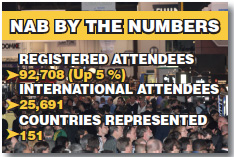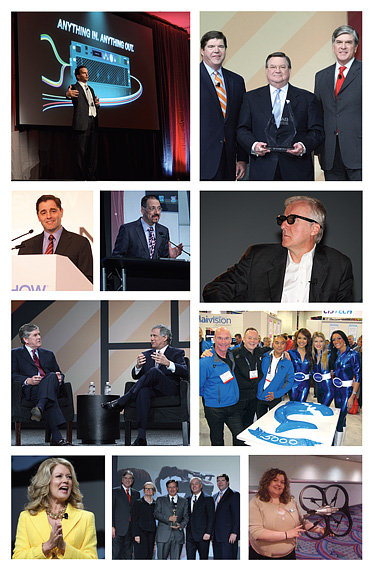Reinvigorated Show Eyes New Hurdles
LAS VEGAS—When attendees left the cavernous convention center on the last day of the 2011 NAB Show last month, what was their foremost impression? Was it optimism, confusion—perhaps relief at getting to rest sore, aching feet?

For certain, this year's annual industry gathering offered attendees a palpable sense of optimism; for the first time in nearly four years, there was a belief that the professional video industry has reached a turning point. After ushering through the transition to DTV and watching millions turn with anticipation to HDTV, the industry has its eye on new horizons: Mobile DTV, 3D and smart-connected sets. And those new guideposts not only seem achievable, but also seem to offer a tangible sense that the industry can be propelled into a new era, one that's profitable, pervasive and technologically savvy.
Said NAB President and CEO Gordon Smith: "The state of the broadcast industry is looking better than it has in two decades," pointing to strengthened ranks of the broadcast faithful and a renewed focus: one that the organization worked to build over the last two years by strengthening lobbying efforts and more effectively championing interests of broadcasting.
All of that is being combined with new technology developments that have created an excitement about the industry that hasn't been seen in some years.
"From the number of people we had coming and the things we talked about, it was as hard to deny the uplift," said Michel Proulx, chief technology officer at Miranda.
SHARED EXPERIENCE

Technology has something to do with that. Today's generation of viewers watch TV differently than they ever have, and are doing so using technology that sways viewership and builds loyalties in unique ways. Surveys report that nearly half of mobile users are watching TV and tapping at their smartphones at the same time, a fact that has begun to dramatically impact how programming is created and marketed.
"It's bringing us back to a shared experience," said Chloe Sladden, director of media partnerships at Twitter, who spoke at a session at NAB. "The connection between TV and Twitter shows that people want a sense of connection and sharing something at the same time. It's very powerful."
The NAB convention is tapping into that powerful realization, and offered sessions at this year's convention that would have been unheard over only five years ago, from "Transmedia" to "Connected TV."
"This is the new business model that broadcasters were looking for," said David Lidsky, an editor at Fast Company and session moderator. "These second screens create an opportunity to advertise not just on TV, but on that smartphone or tablet, to coordinate and connect across that. It's creating a real opportunity for broadcasters to find new revenues. It's no longer a simple trend. It screams to be taken advantage of."
The industry is also pressing forward with Mobile DTV plans, now that signals and receivers are seeping into the marketplace. Yet questions remain about the lack of a unified standard and the need to move away from the traditional broadcast approach of focusing on one large audience when building programming for mobile devices. "We're going to miss most of the new and developing audience if we do that," said Saul Berman of IBM Global Business Services, who spoke at a Mobile DTV session.
3D PUSH
Led by sports productions, the industry is also seeing gains in the 3D space. Sony and Panasonic introduced new stereoscopic cameras, and several NAB sessions touched on the power of 3D to help broadcasters innovate and economize. Just before the show, CBS Sports and ESPN teamed up to cover the back nine of the Augusta National Golf Club during the Masters in 3D. Instead of relegating the 3D crew to inexperienced cameramen, they put their A-list camera operators on the 3D equipment. The result was phenomenal, according to several attendees sitting in the NAB Opening Session, who saw a never-before-aired clip of Tiger Woods taking a few practice swings during that tournament.
"I've never seen Augusta like this on TV," said Phil Orlins, coordinating producer for ESPN, who worked with CBS on its Masters coverage.
Hollywood is paying attention as well. "We realized that broadcast is the future of 3D," said filmmaker James Cameron, who spoke at the Opening Session on the merits of 3D technology and announced a new business devoted 3D programming. "One of the myths about barriers to entry into the world of 3D is that you have to start over from scratch. But it's exactly the opposite."
Added cinematographer Vince Pace, co-creator of the new organization: "For broadcasters, the foundation of what you've currently done will translate well to 3D, and you'll take it even further from there."
DOING MORE WITH LESS
Despite the fact the industry is beginning to rebound from the recession, many conversations focused on whittling down costs, particularly by improving workflows within a station.
"Most people are now dealing with files," Miranda's Proulx said. "Before, tapes dictated a specific workflow: you pick it up, dub it, transfer it to someone. The tape dictated the workflow. Now, it's a lot more open. Now [broadcasters] have a choice when it comes to organizing their business."

David Lidsky The industry—and the convention—continues to have detractors (led by Consumer Electronics Association President Gary Shapiro, who, on the first day of the show, arranged to have an op-ed published in the Las Vegas Review Journal advocating the return of broadcast spectrum to the federal government). Although its core contingency has been TV and radio broadcasters, the organization has attempted to bring other groups under its umbrella at the convention. If it's video, it's of interest to NAB, and that's led the organization to court filmmakers, post production, houses of worship, digital cinema and the military in a new way. That's led some to criticize NAB and the resultant widened focus.
"There's some concern that the show is becoming too diffuse by trying to serve too many audiences—television and radio broadcasters, cable program producers, post-production, Internet media producers and distributors, and even filmmakers," said Len Feldman, a show attendee and new media consultant.
There's also concern over the way the show floor itself is laid out. "It would be great if the show organizers would come up with a well-enforced plan for keeping specific functions together, and keep the plan in place for a few years to allow attendees to become familiar with it," Feldman said.
Yet the show continues to impress.
"The show provides a convenient way to connect vendors, key customers and industry groups such as the ATSC," said Tim J. Carroll, founder of Linear Acoustic." I think it is this unique combination that helps us all address the issues."
The cross-pollination between these groups helps to open the eyes of attendees to market opportunities that they might not have thought about, and technologies that they might not have considered," Feldman added.
The professional video industry's #1 source for news, trends and product and tech information. Sign up below.
Susan Ashworth is the former editor of TV Technology. In addition to her work covering the broadcast television industry, she has served as editor of two housing finance magazines and written about topics as varied as education, radio, chess, music and sports. Outside of her life as a writer, she recently served as president of a local nonprofit organization supporting girls in baseball.

